Although we travelled extensively in South East Asia in the early 1990s we didn’t make it to Vietnam so our visit in 2015 was long awaited. With just two weeks and wanting to see as much as possible, it was going to be a challenge. I normally do my own itineraries and put flights, local transport and accommodation together myself but Vietnam is such a popular destination I found a 4 centre package with Fleetway Travel that I just couldn’t beat. And to be honest, with the quality of the hotels and flights, it was fantastic value.
Ho Chi Minh City
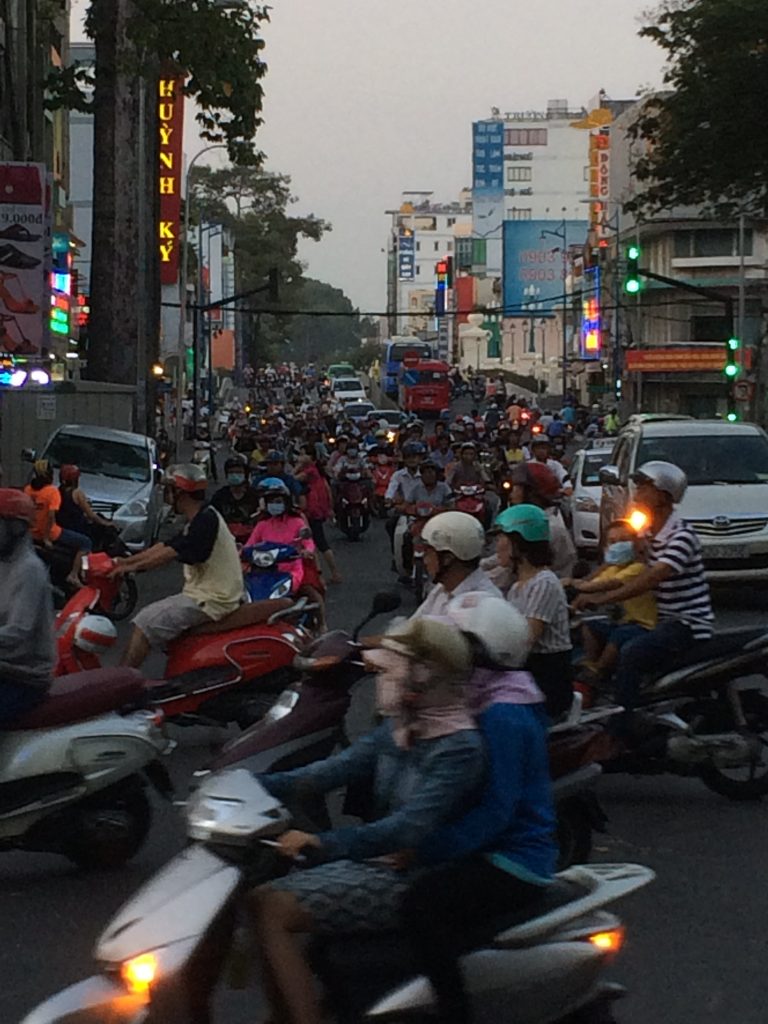
We stayed at the Windsor Plaza Hotel, which was clean and ok as a city centre hotel, although we had little time to make use of the roof top pool. The traffic in the city was the big shocker. We’ve been and seen many Asian cities and thought we had seen everything, from whole families piled on single motorbikes in Morocco, to the trikes and three wheeler taxis nipping in and out of the never ending stream of vehicles in the likes of Bangkok and Manila, to cows meandering through the streets in India. But here the wide roads were just wall to wall motorbikes. Crossing the road was not just a challenge, it seemed like a death sentence, until we watched the locals, and realised that you just walk across the road and the motorbikes go around you. I know! Sounds crazy, but it’s true. The motorbikes don’t stop, they’re not going really fast, but they literally go around you. You have to have nerves of steel at first, and you must walk steady and consistently. If you stop, you’re more likely to get run over. There were four of us and I must admit to walking in the middle of our group, often with my eyes closed, screaming. It was just the scariest thing ever. If it had been left to me on my own, I’d still be stood on the side of the road waiting for a break in the traffic that never happens, as there’s never a break in the constant flow. With 7 million motorbikes in the city, you can imagine how they dominate the roads. But weirdly the system works, everyone seems to get where they want to go and there seemed to be few traffic jams as such, as long as you accepted you couldn’t go any faster because of the volume of traffic. Still scary and for me, the thing I remember most about Ho Chi Minh City. Even at night the traffic didn’t seem to die down and we’ve got some great video footage.
It’s still possible to walk around the city to see the main sights, despite the traffic; you just have to become more confident. The War Remnants Museum is worth a visit, with its helicopters and tanks out front but it’s the graphic images and portrayal of the American war crimes that leaves the lasting impressions on you. We spent a lovely hour or so at the Jade Emperor Pagoda, which was really fascinating and at the time we visited it was full of local worshippers and spirals of smoke from the many incense burners. China Town is another area to head for and to see the Cholan Temples and for those who like shopping there’s Ben Thanh Market.
Viet Cong Tunnels
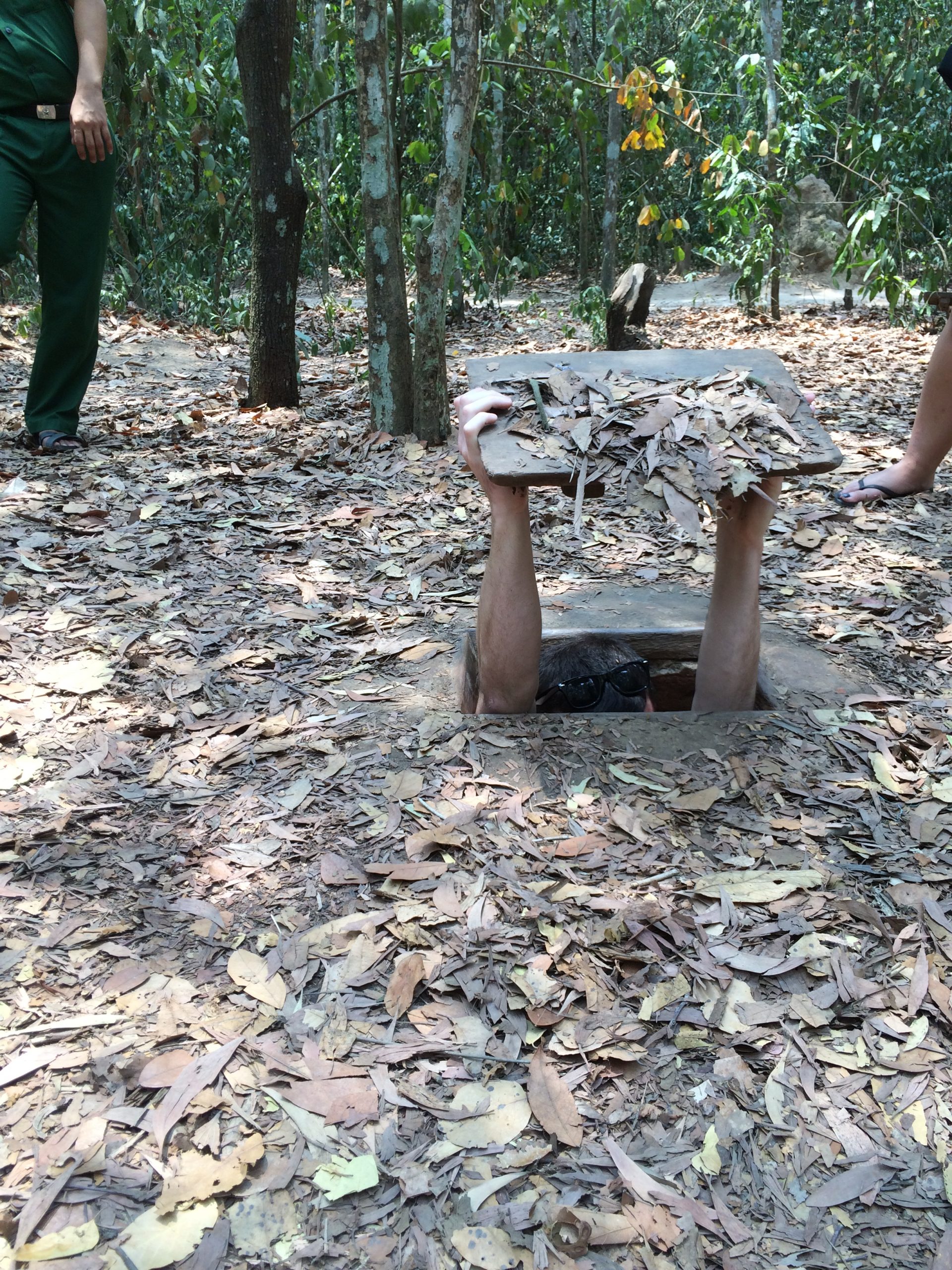
Probably our most memorable trip was a day trip to Cu Chi to see the Viet Cong tunnels. It’s about 30 miles from the city and you can join a tour but we just hired a taxi to take us there. It’s a well-planned, well organised tourist spot and very popular. The guides are really good and very informative. They have opened up sections of the huge network of underground tunnels they used so effectively during the war here. Some of the tunnels had been expanded for tourists to enter with electric lights but the more adventurous could also go into the original tunnels which were so small and narrow and very claustrophobic for westerners. The entrance to these tunnels are so well hidden you start to realise just how the Americans would have felt so vulnerable not knowing where or when the Vietnamese would appear. There are some gruesome displays of the many booby traps they used against the Americans and you can pay extra to shoot rounds of real assault rifles and machine guns. This went down really well with my family, in fact most visitors seemed to participate!
While we were in Cu Chi we looked up the Cu Chi Wildlife rescue centre. It’s a quiet little place with a really sad collection of animals such as black bears, gibbons and leopards. These poor animals have been rescued and are now being lovingly looked after, although it was still clear to see the damage humans have inflicted on them previously, which is very sad.
Mekong Delta and My Tho
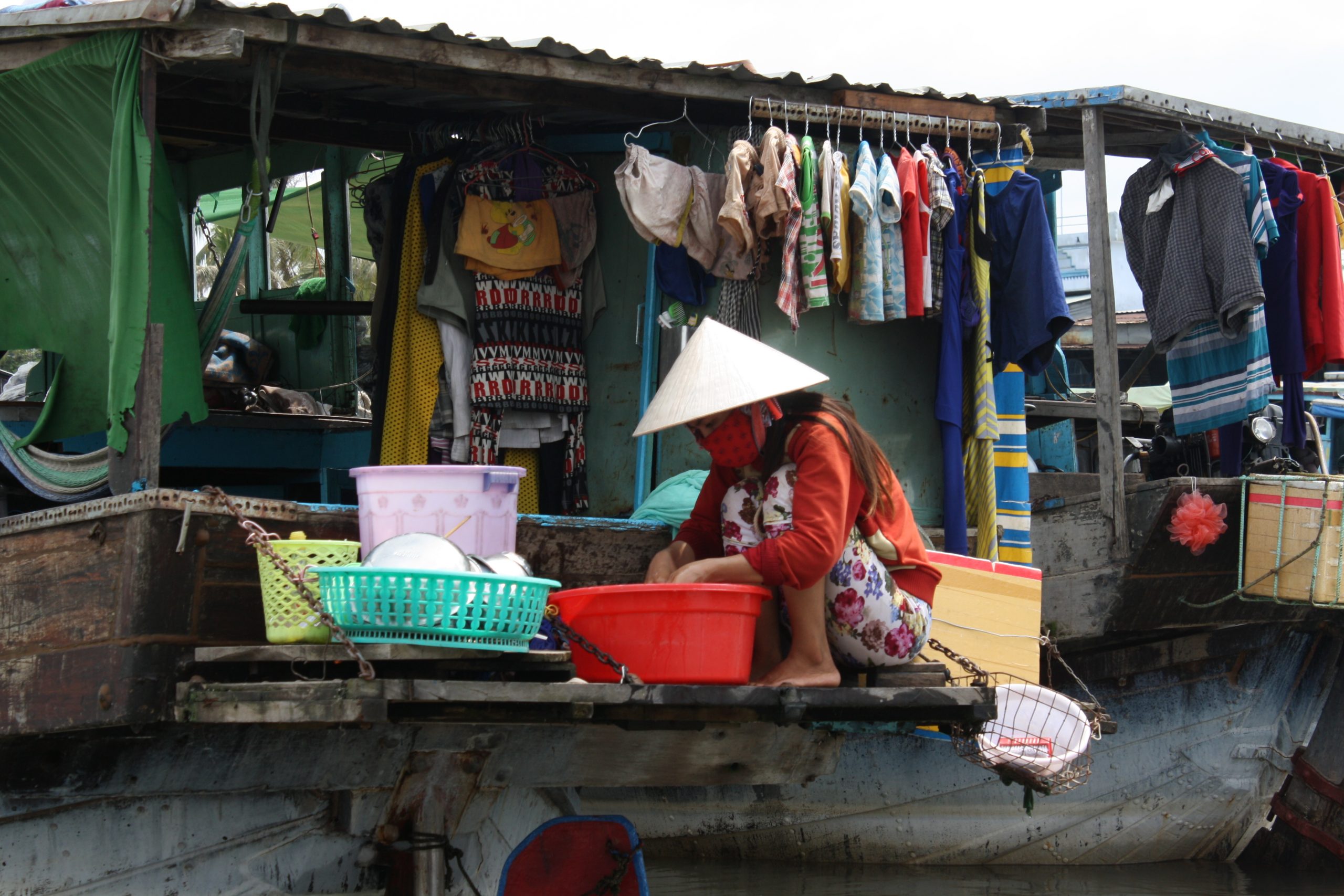
We wanted to do a day trip to the Mekong Delta and its floating markets. The best floating markets are in and around Can Tho however this would have been a 4 hour drive from the city and the markets all take place before 9am so it would have meant leaving at 3.30am or staying overnight. We didn’t have the time unfortunately so we hired a car and went to My Tho instead, which is about a 2 hour drive. Again there are lots of tours from the city, but it’s easy to do it yourself. When you get to My Tho there are many boat trips you can join. We were a little disappointed with the floating markets, we’d seen far better in Thailand, but the ones in Can Tho might have been better. Nonetheless it was really interesting to spend a day in the delta area. Out on the river we could see how much the local’s daily lives revolve around the river, for transport, to sell goods, to wash clothes, to live by the side of the river or in many cases to live on boats. Boats take you to the little villages up and down the main river and then you can board smaller boats paddled by some of the locals to access the many tributaries. It’s much more peaceful away from the noise and industry of the main river and you get to see the wooden houses built on stilts along the side of the river, which were full of life – children playing and having fun in the river, women doing the washing knee deep in the water and men busy tending fields, fishing or mending boats. Our local guide takes us to one of the bigger villages to see some of the cottage industries, making rice and other local produce, with the opportunity to taste and buy samples in their makeshift shops. It’s a really lovely day and we would love to have spent more time in the area exploring and learning more about the Vietnamese way of life.
Hoi An
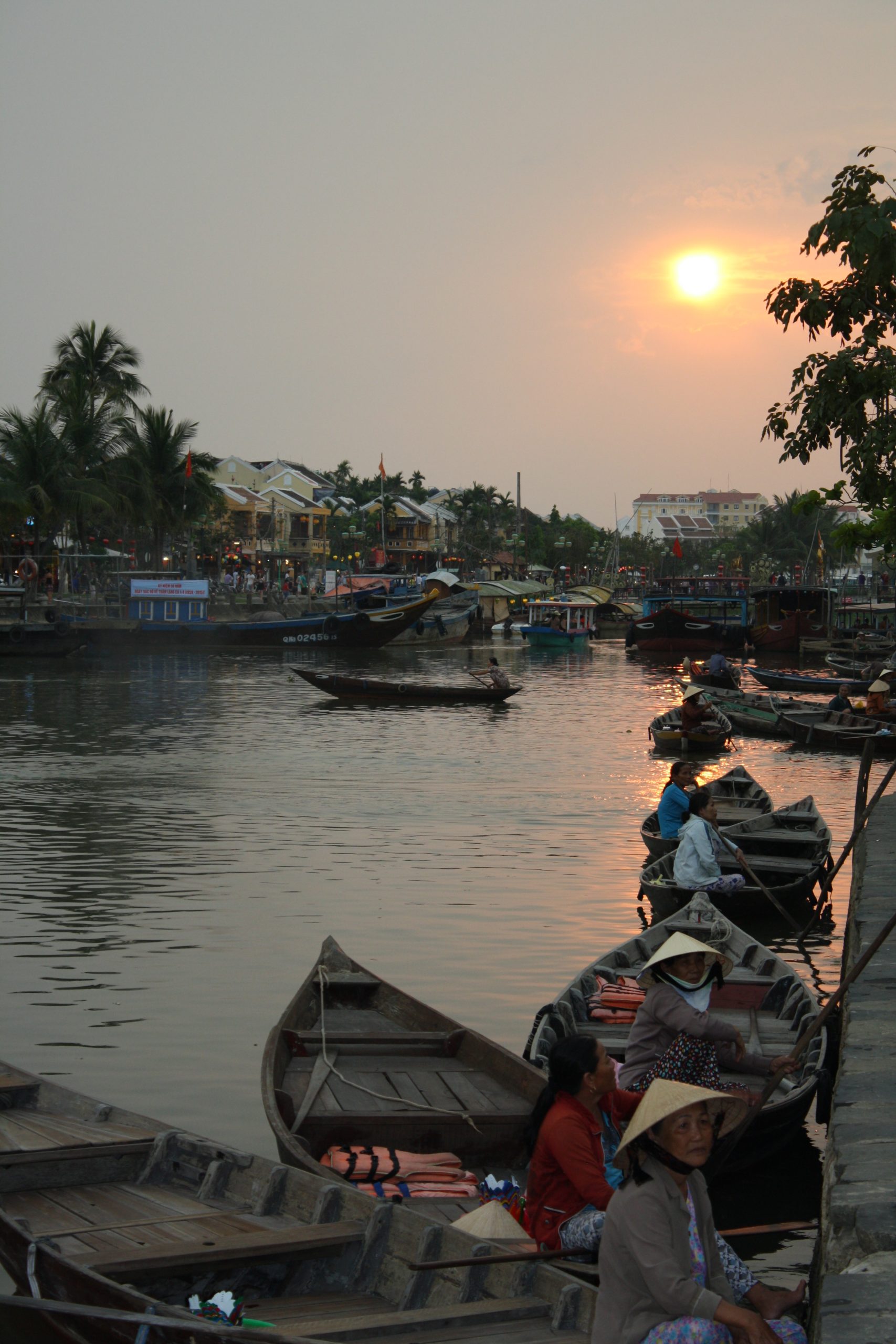
All too soon we have to leave the south and fly on an internal flight to Da Nang heading for Hoi An Beach Resort in Hoi An. The hotel is simply beautiful and far more luxurious than we were expecting! It’s a wonderful base for us to explore the central part of Vietnam and occasionally it was hard for us to tear ourselves away from the stunning pool! But then we discovered Hoi An and there was no competition. Hoi An just stole our heart completely. The hotel puts on regular shuttle buses to and from the centre of town but it’s also a great and safe area to hire bicycles. Hoi An has a wonderful atmosphere and you can quickly understand why this ancient port town was recognised as a World Heritage Site by UNESCO.
We were happy to spend hours just wandering through its narrow streets, exploring the wonderful old buildings, the street life and busy river life. Although the town gets thousands of visitors and it was always busy, day or night, it somehow manages to retain a laid back feel. Hoi An at night is simply a joy, with local people inviting you to light paper lanterns on the river and visitors gather on the historic bridges to watch the lanterns gently weaving their way down stream. We enjoyed some of the best food here in Hoi An, with little restaurants serving not just Vietnamese food but international dishes from across the world. If you have time take advantage of the many cookery schools here! And one of my most memorable days ended in a boat trip along the Thu Bon river as the sun was setting, so special.
You can buy a book of tickets to enter some of the historic building whilst you are here, helping them to maintain and upkeep of the ancient town. You can of course, just wander around yourself without spending any money but it really is worth doing. It’s a way of keeping these amazing ancient buildings alive but also, they really are interesting. You can choose 5 buildings to visit and we chose the Museum of trading Ceramics, the Fujian Assembly Hall, Tan Ky House, Quan cong temple and the Japanese Bridge.
The road to Hue
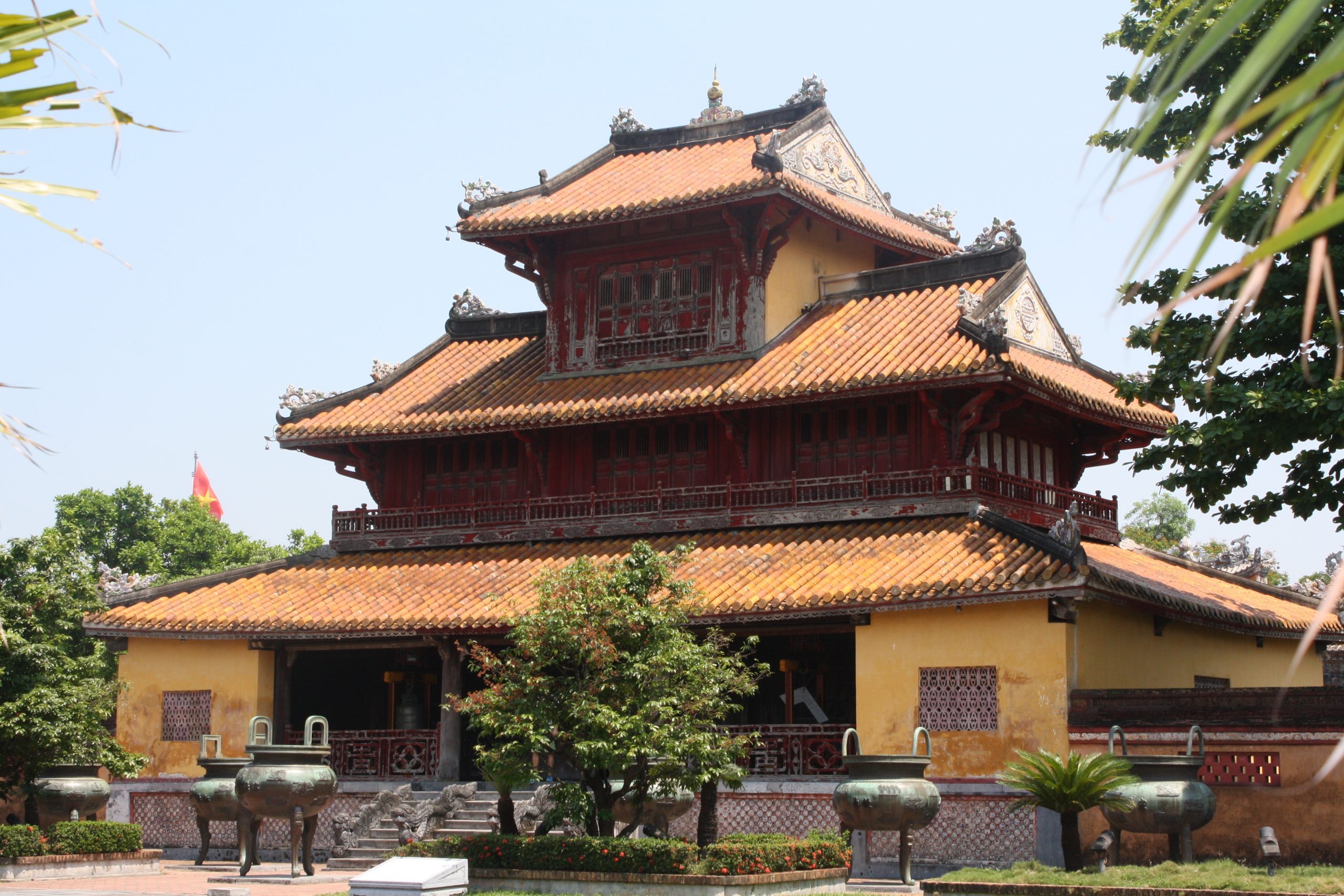
We wanted to see as much as possible and hired a mini bus and driver/guide to take us to Hue, 126 Km north of Hoi An. The trip up there was lovely as we stopped along the coast to watch early fishermen bringing in their catch and then drive up for spectacular views from Monkey Mountain and Marble Mountain (Nui Son Tra). But it’s still a long way and it was well after lunch before we reached Hue. It’s a beautiful town and there is so much to see here. Highlights for me were the Mausoleum of Emperor Tu Duc which is set in peaceful gardens around a lake, and the imposing Imperial City, with its stone walls, moats and mosaic palaces.
Vinh Moc Tunnels
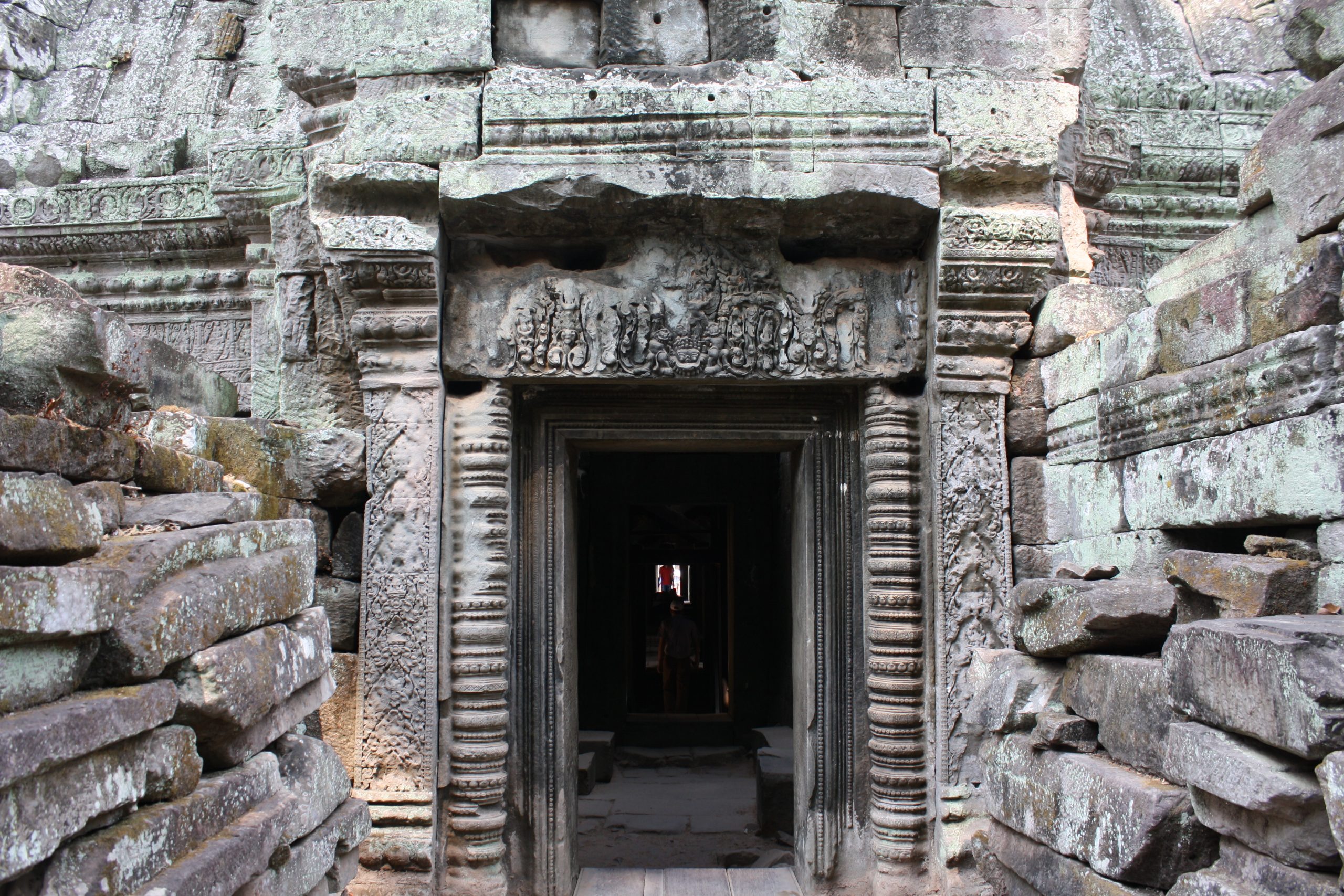
In our wisdom we pushed on past Hue and continued up via the demilitarized zone, just stopping for photos across the bridge, and Dong Ha to find the Vinh Moc Tunnels. I say find because although our guide and driver said they had been here before it soon became obvious this was also their first visit as we drove round and round looking for the place. By the time we got there it was about to close so we were fortunate to be able to get into the tunnels. Unlike the network of fighting tunnels at Cu Chi, this was an underground village, where people hid and spent their lives underground to stay safe from the bombing. It was hard to image how they dug the complex which had individual living spaces for families and even a hospital. Although much bigger than the Cu Chi tunnels, they were still claustrophobic and it must have been pretty scary to live there during the bombing. At one point the tunnels come out high on the cliff edge with spectacular views out to sea. Our guide and driver were just as excited as we were and took just as many photographs!
Now getting dark, the long trip back to Hoi An was probably one of the most frightening road trips we’ve ever done! They drove very fast and the roads were just as busy as in the day with everyone overtaking on the single lane roads, just horrific. We were just relieved to survive and get back safely, but we had packed in so many miles and seen so much it was a very satisfying day!
My Son Temples
Still using Hoi An as a base we took a trip out to visit the My Son temples about 55km away and we just hired a car to get there. Hidden between the jungle and the forests this ancient Hindu temple complex is a little bit off the tourist track but well worth a visit. Lacking the crowds and in such a beautiful position, I can’t imagine it will stay hidden for too much longer. The temples are built in an unusual red brick with no mortar to hold them together, it’s hard to imagine how they are still standing when many were built as early as 4th century AD. There’s a lot of damage to the temples from the Vietnam war and you can still see huge craters in the ground around the temples.
Siem Reap, Cambodia
Our third centre takes us to Siem Reap in Cambodia and we stay at the Hotel Somadevi Angkor, a wonderful oasis in the madness of Siem Reap. Our short stay in Cambodia is all about visiting Angkor Wat, although I’m keen to see more of the Cambodia countryside so there are side trips aplenty whilst we are here!
With a short space of time, there’s little rest or time to appreciate the pool at the hotel, although it was very welcome on the return from a long, hot day walking around the temples!
The first thing that hits you is how commercial Cambodia is, well Siem Reap is! Everything is in dollars and everything is very expensive (compared to the rest of Asia) and it’s really full on commercial. It’s a bit of a smack in the face, a bit like the sun that is unrelenting in this part of the world. Siem Reap wasn’t what I was expecting. It’s very busy, very commercialised and even has a bar street, full of bars and clubs to beat any in Thailand. You can try lots of different delicacies here and it seems to be a right of passage to try the many fried insects you can eat. There are however some good restaurants too! I must admit Siem Reap wasn’t my favourite place in South East Asia.
Angkor Wat
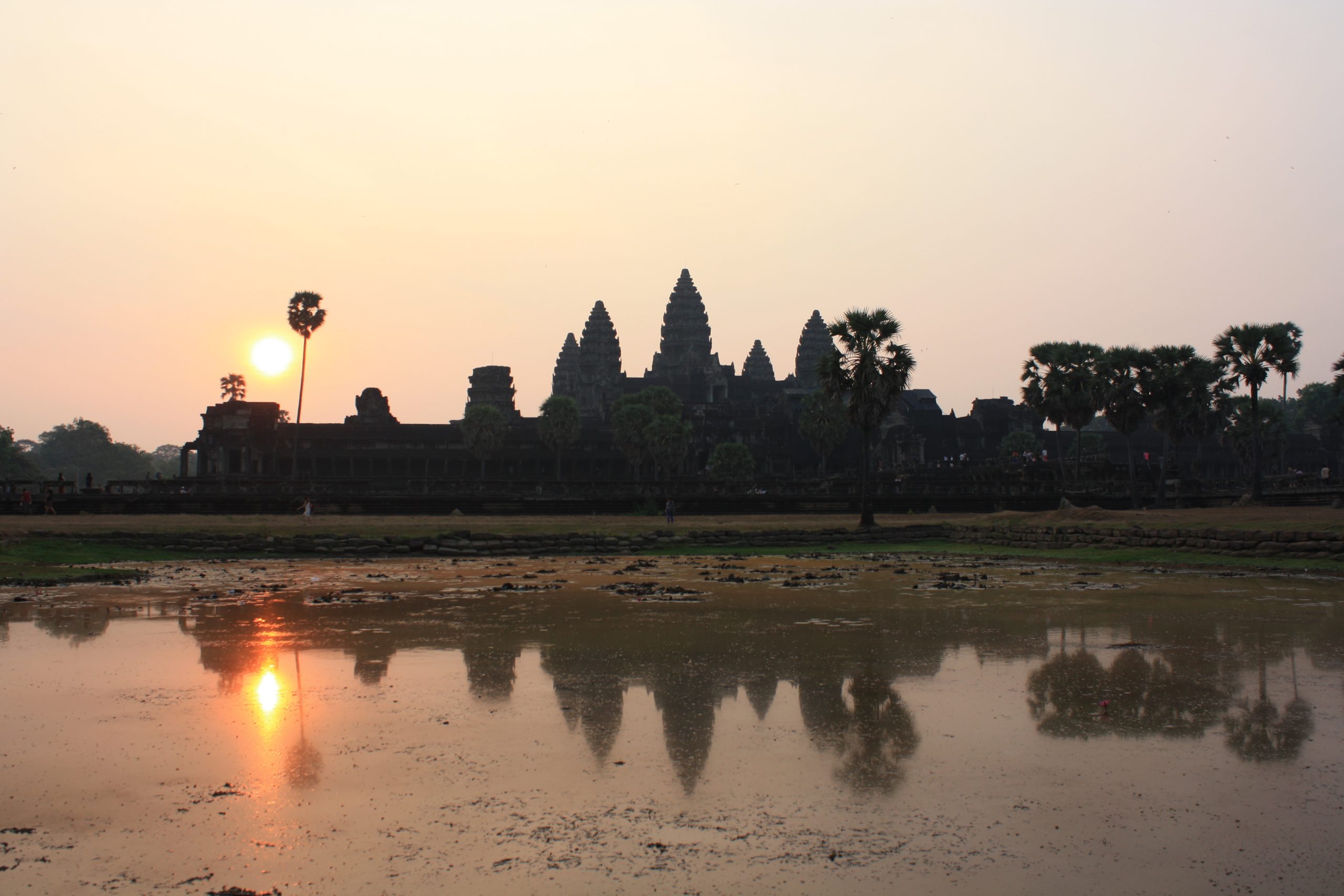
I think places as famous as Angkor Wat get a little bit frantic and there’s so much written about where’s the best place to get the perfect sunrise shot, the best place to beat the crowds, how to see everything….it’s just not possible and it can get stressful. Go to Angkor Wat and expect crowds. Go to Angkor Wat and expect to see a beautiful sunrise and a beautiful sunset. You may not get a photograph without people in it but see beyond the people. The place is breath-taking. You could spend days and weeks here exploring the temple complex and you would still be discovering new things and enjoying its splendour. So don’t let the hype or the pressure spoil the experience for you, just marvel at one of the wonders of the world (even if it is eighth!) You’ll be amazed at the sheer size of the site, which just seems to go on and on for miles. You have to keep reminding yourself that these temples were built in the 12th century, how is that even possible? There’s little wonder that people flock here from all over the world, whether it is in awe of and in appreciation of the spectacle that it is, or whether for truly religious meaning. And never forget that. This is one of the most revered temples in South East Asia, built as a spiritual home for the Hindu god Vishnu.
I’m not even going to try and recommend where to go, what to see, at what time! Go. Go at sunrise, see as much as you can, explore the lesser known temples just as much as the main ones and see the sunset. Even if you don’t get the perfect photograph without people in it (very unlikely), you won’t be disappointed. Just remember it will be hot so take lots of water. You will have to walk lots, so wear comfortable shoes. And you will have to cover up to get inside the temples, in fact, out of respect, don’t walk around in shorts and skimpy t-shirts, and remember this is a hugely religious site.
Tonle Sap Lake
Keen to see more of the countryside and get out of Siem Reap we hire a taxi to take us to Tonle Sap Lake, the largest lake in Cambodia. You don’t have to go far out of Siem Reap and you can see that the majority of people live in the countryside in relative poverty. The villages are very basic and even the fields look sparse of vegetation, maybe it’s the searing heat. We get a long boat to take us down the river to reach the lake. We’re heading for Kampong Phluk, a floating fishing village constructed on stilts in the swamps of the lake. Only a handful of tourists make the journey by boat or bus to Kampong Phluk, which has helped the village retain much of its authenticity. This is the place to go to see daily Khmer life away from the influence of heavy tourism. The people are welcoming and desperate for you to come and spend money in their floating shops and restaurants. But they’re understandably wary, probably having seen the huge development in Siem Reap, but I’m not convinced the local people get to see much of that investment, a lot of it is Chinese. The lake is really interesting and there’s also a bird sanctuary.
War museum
Siem Reap suffered horribly under the Khmer Rouge, and the area’s victims are commemorated today in a monastery. A glass-walled stupa on the premises holds a mass of bones belonging to massacre victims. Just like its counterpart Tuol Sleng in Phnom Penh, Wat Thmei provides a stark reminder of the insanity that ruled Cambodia in the 1970s.
The War Museum in Siem Reap is the biggest War Museum in Cambodia and should definitely be on your list of places to visit. In a quiet part on the edge of the town, nearly in the countryside, there is a collection of tanks, fighter aircraft and artillery guns on view. But what was so memorable were the local guides who work there. We practically spent the whole afternoon there listening to our guide, who was only 54 and had been involved in the war since a young boy. He was also a landmine victim and had lost many of his family. His personal story brought to life the terrors most people in Cambodia faced during the last three decades of the 20th century. It offers visitors a unique and insightful view of the perils that Cambodia faced during the last 3 decades of the 20th century, just heart breaking.
Hanoi
Another flight and our final base was Hanoi in the north of Vietnam. We stay at the Calypso Grand Hotel, a small but friendly place in the centre of the city. It’s noticeably cooler here in Hanoi compared to Cambodia. We’re soon out and about exploring this ancient city, with its busy, narrow streets, full of life. We love the Old Quarter and the area around Hoan Kiem Lake and visit the Ngoc Son temple. In the evening we go to one of the renowned water puppet theatre shows that are so famous in this part of Vietnam.
Halong Bay
The next day we take the three hour bus trip to the coast for our one night cruise on board Alova Gold. The weather is still not good, in fact, we’re worried as the wind is picking up and there are dark clouds on the horizon. We’re soon told that there is a typhoon forecast for that night and all boats are going to have to come back to shore so we’re only going to have an afternoon on the boat. We’re gutted. It’s a lovely afternoon exploring the beautiful limestone scenery around the bay, but could definitely appreciate that this would just look stunning in the sunshine.
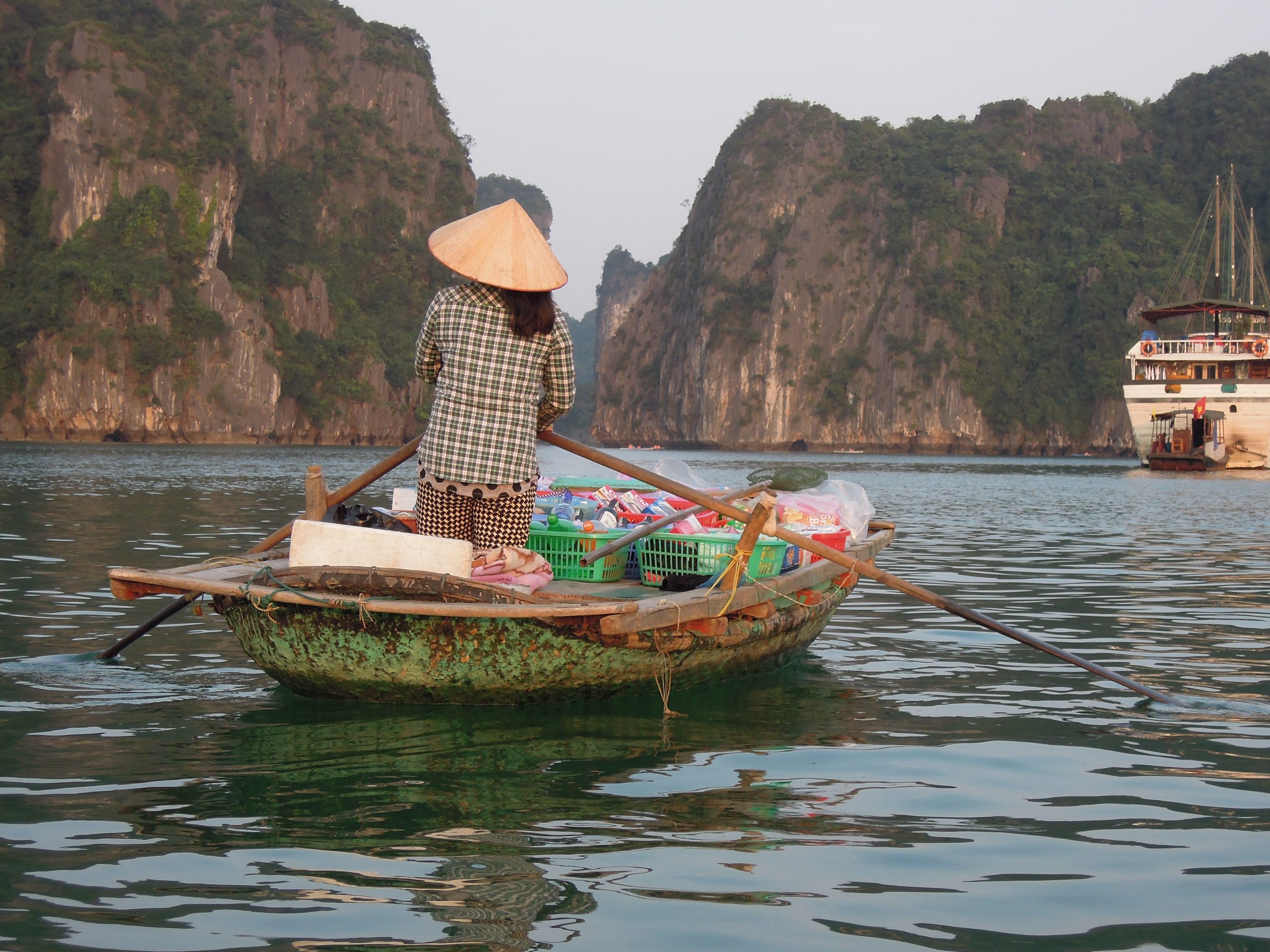
Back in Hanoi we realise we cannot argue with the weather however we take issue with the travel agents and there’s an opportunity if the weather clear we can join another one night cruise the next day. It means we lose some time that we were going to explore more outside of Hanoi but Halong Bay is something we particularly wanted to see, so we think it’s worth the second trip. And it so didn’t disappoint. The sun shone for the whole two days and we were on a small boat with a group of about 12 others. There’s lots of room on the boat with a sun deck to appreciate the weather and the beautiful sights. It’s full board on the boat and we enjoy a wonderful lunch before we stop to one of the main viewing areas and we can get off the boat and climb high up one of the limestone crops where the views are simply spectacular. We also get to see some limestone caves here that have developed over thousands of years. Back on board we sail on to a sheltered bay area where we’re all able to go kayaking for a few hours. This was by far one of the best moments of the trip, it was just so beautiful, so peaceful and we kayaked until sunset. Local people sell drinks and trinkets in their little boats and appear from out of nowhere whenever a tourist boat arrives. It’s time to shower and change for dinner back on board. We sit and meet up with an Australian lady travelling with her grown up daughters. We all get on really well and we have a few drinks into the evening before we retire to our bedrooms. The next day we sail on and enjoy a sunny morning on deck, taking in the views. It’s a very special place and we are so pleased and feel so grateful that we did get to experience Halong Bay in the sunshine. If you go to Vietnam, it has to be on your list. Even though thousands of people are doing the same and there are lots of boats out there at the same time, it’s such a big area, you never really feel on top of each other. It’s a beautiful end to a fantastic trip.
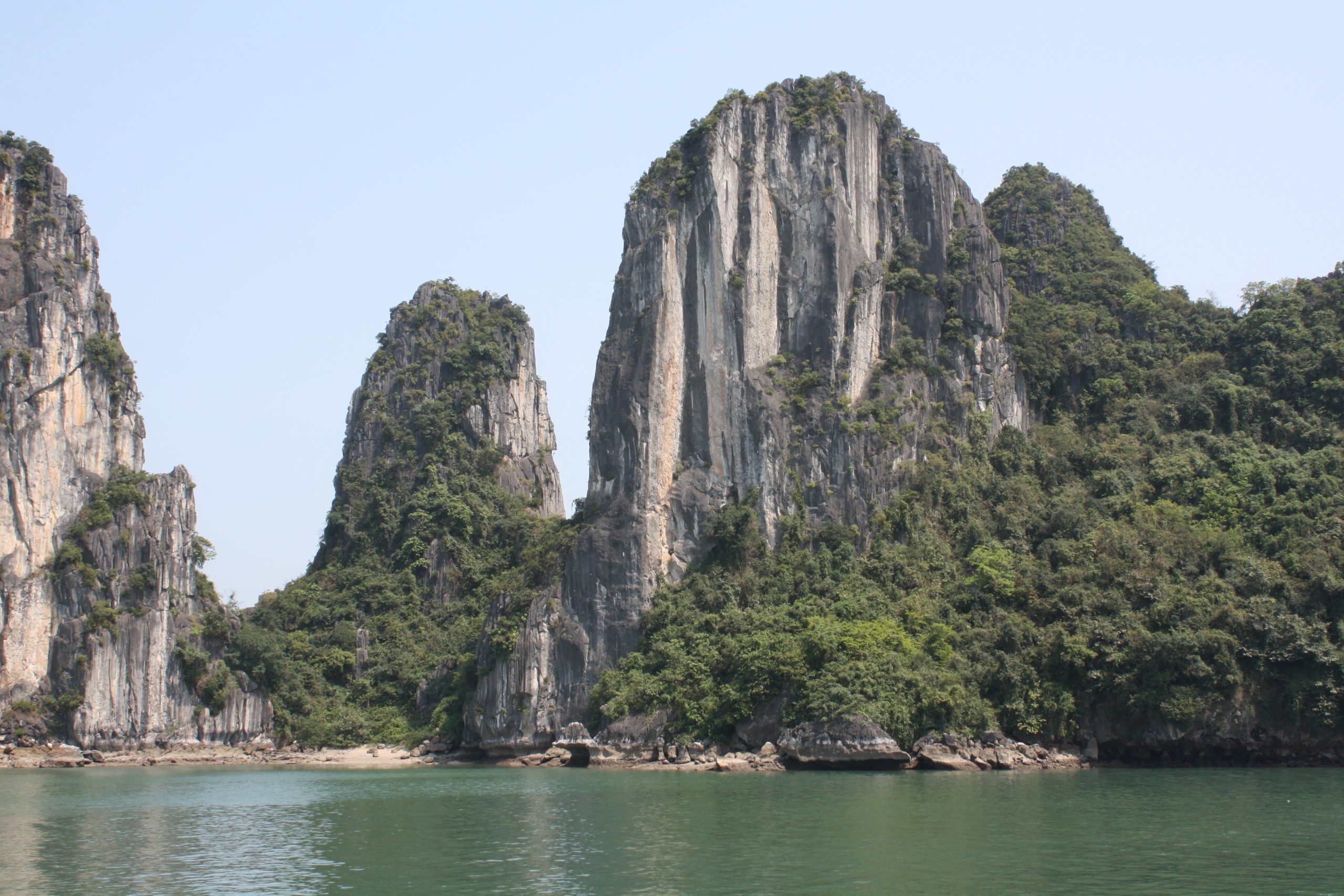
Vietnam has been a joy and somewhere we’d like to explore more of in the future. We’ll definitely be back to do more on our own. But I can definitely recommend the four centre from Fleetway Travel, it was such great value.
